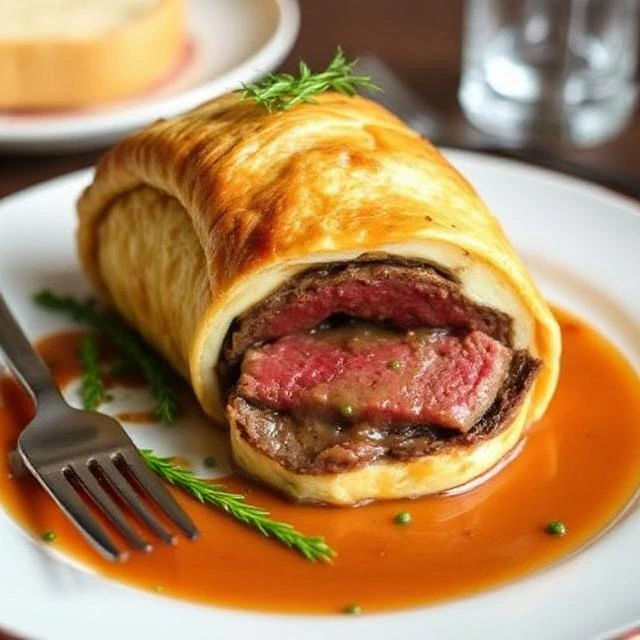INTRODUCTION
Beef Wellington is the epitome of culinary elegance—a dish that combines tender beef, rich mushroom duxelles, and buttery puff pastry into a showstopping centerpiece. Often reserved for fine dining, this recipe demystifies the process, allowing you to recreate a restaurant-quality Beef Wellington in your own kitchen. Whether you’re hosting a holiday feast or impressing a date, this guide covers every step, from selecting ingredients to flawless execution.
Why Beef Wellington?
Beef Wellington’s allure lies in its harmonious layers of flavor and texture. Originating in 19th-century England (and possibly named after the Duke of Wellington), this dish has become a symbol of gourmet cooking. Here’s why it’s worth mastering:
- Unmatched Elegance: Perfect for special occasions or elevating weeknight dinners.
- Customizable: Adapt fillings and pastry to suit dietary preferences (e.g., gluten-free puff pastry).
- Crowd-Pleasing: A golden, flaky exterior gives way to juicy beef—guaranteed to wow guests.
For inspiration, explore Gordon Ramsay’s Beef Wellington (external link), a benchmark for this classic dish.

Ingredients You’ll Need
(Serves 6-8)
1. The Star: Beef Tenderloin
- 1.5–2 lbs center-cut beef tenderloin (trimmed and tied).
Why? Tenderloin’s lean yet tender texture holds up during baking.
2. The Flavor Builders
- 8 oz cremini mushrooms (finely chopped for duxelles).
- 2 tbsp Dijon mustard (for brushing the beef).
- 6 slices prosciutto (or thinly sliced pancetta).
3. The Pastry
- 1 sheet puff pastry (thawed; use gluten-free if needed).
- 1 egg (for egg wash).
4. Aromatics & Herbs
- 2 garlic cloves (minced).
- 2 sprigs fresh thyme (or 1 tsp dried).
- Salt and pepper (to taste).
Pro Tip: For a deeper flavor, add a splash of brandy to the mushroom duxelles.

Step-by-Step Instructions
1. Prep the Beef
- Season: Generously salt and pepper the tenderloin.
- Sear: Heat oil in a skillet over high heat. Sear the beef on all sides (2–3 minutes per side) until browned.
- Brush: Let the beef cool slightly, then coat with Dijon mustard.
Internal Link: Learn how to sear meat perfectly for maximum flavor.
2. Make the Mushroom Duxelles
- Sauté: In the same skillet, cook mushrooms, garlic, and thyme until all moisture evaporates (8–10 minutes).
- Season: Add salt, pepper, and a splash of brandy (optional). Let cool.
3. Assemble the Wellington
- Layer Prosciutto: On plastic wrap, arrange prosciutto slices into a rectangle.
- Spread Duxelles: Top prosciutto with an even layer of mushroom mixture.
- Wrap the Beef: Place the beef in the center and roll tightly using the plastic wrap. Chill 15 minutes.
4. Encase in Pastry
- Roll Pastry: On a floured surface, roll puff pastry to ¼-inch thickness.
- Wrap Again: Unwrap the beef bundle and place it on the pastry. Fold and seal edges, trimming excess.
- Egg Wash: Brush with beaten egg for a golden finish.
5. Bake to Perfection
- Preheat Oven: 400°F (200°C).
- Bake: 25–30 minutes until pastry is golden and internal temperature reaches 125°F (medium-rare).
- Rest: Let rest 10 minutes before slicing.
Pro Tip: Use a meat thermometer to avoid overcooking.

Pro Tips for Success
Avoid common pitfalls with these expert strategies:
- Chill Between Steps: Keep the beef cold to prevent pastry from melting prematurely.
- Even Layers: Spread duxelles thinly to maintain structural integrity.
- Vent the Pastry: Cut small slits to release steam and prevent sogginess.
For troubleshooting, check out America’s Test Kitchen’s Beef Wellington Guide (external link).
Creative Variations
Adapt this classic to suit your tastes:
- Vegetarian Wellington: Swap beef for portobello mushrooms and lentils.
- Truffle Twist: Add truffle oil to the duxelles for luxury.
- Holiday Version: Wrap in bacon and serve with cranberry sauce.
Internal Link: Try our Festive Vegetarian Wellington for a meat-free alternative.
Serving Suggestions
Pair your Wellington with these accompaniments:
- Creamy Mashed Potatoes: Ideal for soaking up juices.
- Roasted Vegetables: Asparagus or Brussels sprouts add freshness.
- Red Wine Sauce: Reduce red wine, beef stock, and butter for a decadent drizzle.
Wine Pairing: A bold Cabernet Sauvignon or Pinot Noir complements the richness.
FAQs
Can I prepare Beef Wellington ahead of time?
Yes! Assemble up to the pastry stage, refrigerate overnight, and bake before serving.
How do I prevent a soggy bottom?
- Chill the wrapped beef before adding pastry.
- Blind bake the pastry base for 5 minutes if needed.
What if I don’t have puff pastry?
Use phyllo dough as a lighter alternative, though texture will differ.
Storing and Reheating
- Refrigerate: Store leftovers (wrapped tightly) for up to 3 days.
- Freeze: Pre-baked Wellington freezes well for up to 2 months.
- Reheat: Warm in a 350°F oven until heated through (avoid microwaving).
CONCLUSION
Mastering Beef Wellington is a rewarding culinary achievement. With its golden crust and succulent center, this dish transforms ordinary dinners into extraordinary experiences. For more gourmet recipes, explore our Guide to French Cuisine or Jamie Oliver’s Holiday Recipes (external link).
Share your Wellington creations with #HomeGourmet and tag us—we’d love to see your masterpiece!